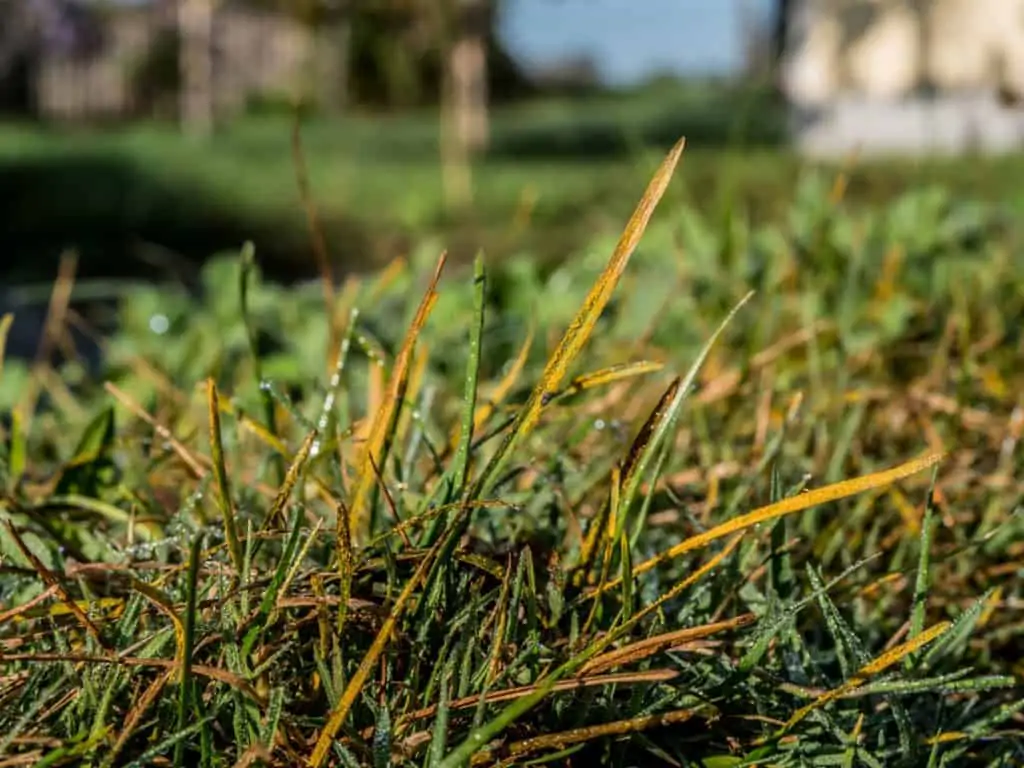Lawn rust is a powdery substance that looks rusty in substance, it appears in spots, or can completely cover a grass blade and can be brushed off easily. Though it is a relatively usually lawn disease it is easily identified when examined up close.
When in its powdery form, it is easily spread, it can spread by wind, or by grass blades brushing up against one another, or by people or animals brushing up against it by walking through it.
You can combat it by minimizing shaded areas in your lawn, doing so can help kill off the lawn rust and prevent it from reappearing.

You should not apply fungicides unless the infestation of lawn rust is very severe. On the odd occasion lawn rust may go away on its own if the lawn is properly fertilized.
In many ways grass is much like us, it can combat a disease like lawn rust if it is healthy enough, so ensuring that the grass receives adequate sunlight, water and fertilization can help to strengthen it and assist the grass in gaining enough strength to right off the infestation.
The best way to get rust to go away is to prevent it in the first place, preventative measures and the measures used to make it go away are the same, simply keeping the grass healthy and ensure that it is growing healthy and strong.
What causes rust?
Lawn rust is a common foliar disease of turfgrass. Caused by various fungi, often puccinia or uromyces species of fungi. Infected areas may produce large numbers of air-borne spores.
Orange pustules produce summer spores, these can be carried for long distances in the wind They will need a few hours of surface wetness to germinate and then infect the lead.
Therefore, lawn rust is most common in wet summers, it is also common in autumn when there are heavy dew that provide extended periods of leaf wetness. The black pustules will produce over wintering spores that have adapted in order to survive in colder conditions.
Lawns that lack in vigor and strength, often caused due to nutrient deficiencies or drought stress in the drier months will be more susceptible to an attack by these fungi’s that cause lawn rust.
Rust is most noticeable on long grass or in areas covered by trees or shrubs hanging over the lawn. In situations where this is the case the grass does not dry out as fast, it lacks the sunshine that will help it dry out.
When the grass cannot dry itself out fast enough it becomes an ideal breeding ground for these fungi and bacteria.
Grass that is hidden in uncomfortable, unhealthy conditions, or is in a place where it does not have sufficient access to sunlight, drying out after rains, or conditions that will give it optimal health will make it a target for rust to grow.
The best way to avoid it is to keep your grass as healthy as possible.
Does rust kill grass?
Rust based diseases in grass are some of the oldest known diseases to attack grasses. They can only attack living grass, and they are completely capable of killing leaves, however they do not generally kill off the entire plant.
Grass is typically very difficult to kill off, rooting deep in the soil. The fungi that causes these diseases cannot grow inside the soil or decompose the thatch of the leaf.
These fungi are simply pathogens, and for a rust disease to develop or hurt your turf the weather must be both wet and warm and the grass underneath must be fertilized.
Rust will only attack the leaf blades of the turf and if you have a keen eye you may notice the rust-colored turf leaves may turn to a black powder on their surfaces in the fall months.
Rust fungi will likely cause the grass blades to turn yellow, and it will stunt the growth of your turf all together.
So it will not kill the grass directly, but it will weaken it which then opens it up to further problems, and makes it more likely to be a target of other diseases and bacteria.
How do I get rid of rust in my lawn?
The best way to get rid of lawn rust is to nourish your lawn, obviously this is less likely to work if your grass is too far gone, however it can work however bad it is.
You should feed your lawn small amounts of a slow-release nitrogen fertilizer every six weeks, using 0.2 to 0.5lbs of nitrogen per 1,000 square foot is a good amount.
Give special attention to fungus prone areas, such as shady spots that do not get much sun. Be clear of nitrogen fertilizers in the fall, if there is too much growth towards the end of the season will leave grass vulnerable to other issues.
You should also water in the morning to avoid damages from heat stress without it being damp.
Watering in the cooler hours of the early morning will give your grass a chance to dry out during the day. You should avoid watering in the evenings because this creates an ideal breeding ground for lawn rust.
Mow regularly, keeping it at about 1 ½ inches, moving when it gains an inch or so, rake up the grass clippings or sweet with a lawn sweeper.
Regular mowing a raking removes any fungus affected grass which not only makes your lawn look better but also prevents fungus from spreading.
You should also improve the air circulation, if the air circulation is bad then it will help fungal spores to form. You can use a thatching rake to break up any thatch that is more than half an inch deep.
Then remove the thatch with a leaf rake. You can also use an aerator to reduce soil compaction so water and fertilizer can reach the roots of your lawn blades better to let the blades breathe better.
